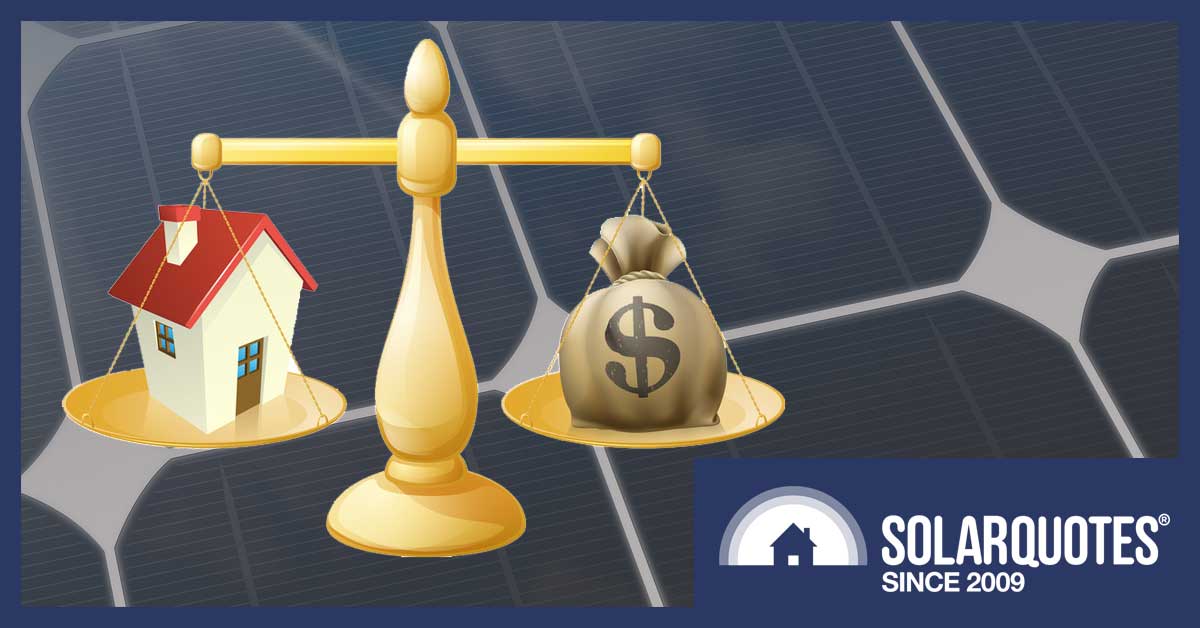
Are you willing to trade control of your home battery for cash payments? Then a Virtual Power Plant may be for you. Our VPP table lets you compare offers.
Do you own a home battery, or are planning to get one? Then I have good news. The SolarQuotes Virtual Power Plant (VPP) Comparison Table is up and running. So if you are interested in joining a VPP, you’d better go catch it.
If you’re not feeling energetic enough to chase it down, don’t worry. It’s only new and isn’t running at high speed at the moment. It’s still a work in progress.
We made it because we want to help you get the best deal possible. We also have the ulterior motive of not wanting to be cooked by global warming and are more than happy to help out with anything that may prevent that. (We have a weak spot for future generations.) At the moment the table has information on 11 VPPs available in various parts of the country. We’ll add more as information becomes available and we’ll even get around to improving the layout and presentation.
In this article I’ll quickly go over what a VPP is and why you might want to sign up your home battery to one, and then I’ll go over the details of our comparison table. If there are any improvements you’d like to see made to it, please leave suggestions in the comments.
What Is A VPP?
VPP stands for Virtual Power Plant. It enables your home battery to team up with others and — by their power combined — provide a lot of power. By submitting to centralized control and acting in concert they can behave virtually the same as a traditional power plant, providing power when needed and providing stability to the grid.
Because VPP are treated much the same as a large scale battery or hydroelectric pumped storage facility, they have advantages that aren’t normally available to individual households, such as selling and buying electricity at wholesale instead of retail prices. This means Virtual Power Plants can sell electricity to the grid when the price is high and charge up when the price is low, zero, or negative. They can also receive payments for ancillary services that help keep the grid operating smoothly.
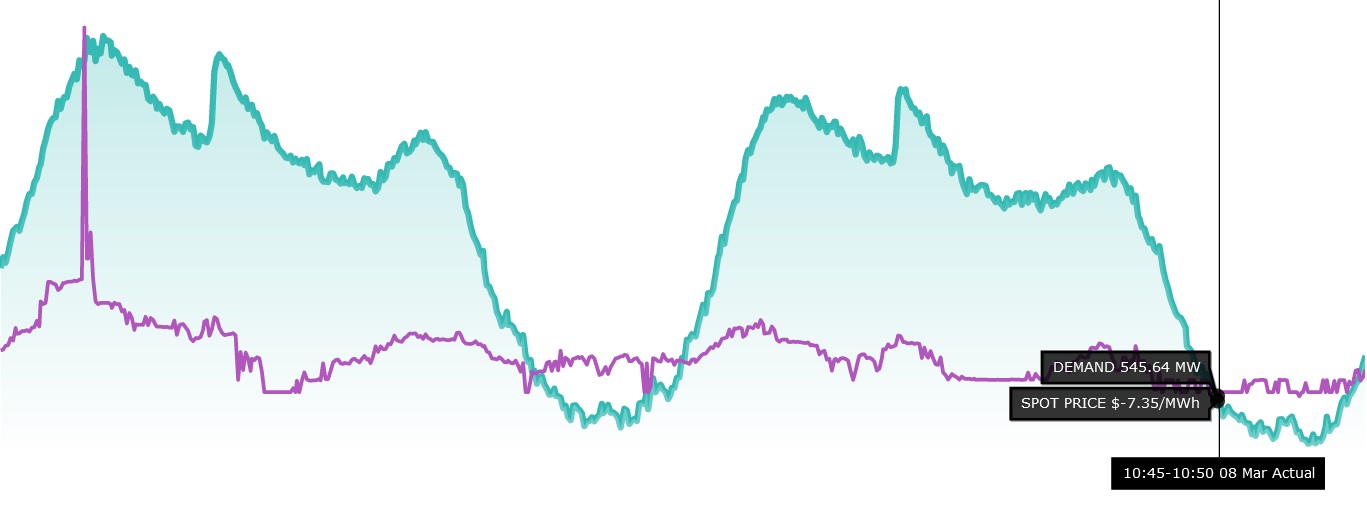
This graph from the AEMO shows a brief 5 minute period where electricity prices went negative on Sunday morning in South Australia. This is a pretty relaxed wholesale price graph. There are plenty of times when prices are far more extreme. Even that high spike on the left is only 27.7 cents per kilowatt-hour. During heatwaves, it can go over $10 per kilowatt-hour.
Why Would I Want To Join?
You may be wondering why you’d want to join a VPP. Perhaps you’re happy just using your home battery to reduce your grid consumption and provide backup for the ecto-containment system in your garage:
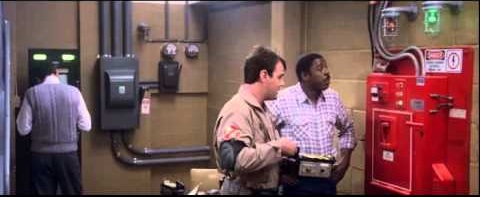
Seriously guys, Egon specifically said the wiring was sub-standard but you don’t have a battery bank hooked up to this thing?
If this is the case and maintaining control over what happens to your battery is important, then a VPP is not for you. The electricity retailer operating your Virtual Power Plant will, to varying degrees, use power from your battery when it suits them and not when it suits you. Despite this, there are good reasons to join a VPP. Four big ones are:
- They supply power to the grid where it’s needed, reducing the need for long distance and local transmission, lowering the cost of electricity for all.
- They can provide ancillary services that help stabilize the grid, again lowering the cost of electricity for everyone.
- They make it easier to integrate variable renewable energy sources such as wind and solar power into the grid, helping renewable energy expand.
- They will give you money if you participate.
That final point is going to be the main determinant of whether Virtual Power Plants take off or not. Mo’ money, mo’ VPP members.

This is literally going on inside the funkier VPPs right now. The trouble is, sometimes, only the VPP operators get mo’ money and the battery owners get mo’ problems.
VPPs May Make Batteries Pay
With the right circumstances and the right VPP a suitable home battery may pay for itself. There are some deals out there that — on the surface — look pretty impressive. But it’s very important to dig below that beautiful shiny surface and make sure your VPP is actually full of money and not financial nastiness.
I intend to do a fair bit of digging into VPP plans over the next few months. I’ll go into detail and let you know if I find any that contain nuggets of financial goodness or if they are full of… other nuggets that are less pleasant. Each time I do a deep dive into a Virtual Power Plant a link will be added to the table.
Why VPPs And Not Big Central Batteries?
Sometimes I hear people — often people who are quite clever and intelligent but who don’t quite fully grasp the concept of greed — say things like:
“How can VPPs compete with large utility scale batteries like the Tesla Big Battery when they have to use a mish-mash of different battery types, some which may have been installed by the Dodgy Brothers, when big companies can purchase batteries in bulk and maintain complete control over their environment, use, and maintenance?”
Whenever I hear something like this, I end up sitting there blinking and thinking, “Because money!”
Specifically, other people’s money. As in your money. The VPPs want to make money from the money you’ve spent buying and installing a home battery. For them, it’s like free money, except competition between Virtual Power Plants is supposed to prevent them from ripping consumers off. Unfortunately, for consumers:
- VPPs are still in their trial phases, so there’s not much competition at the moment.
- Similar to electricity retailing, VPP competition at the retail level is not likely to be efficient. I expect it to be worse as Virtual Power Plants are more complex.
I think the government should protect the interests of consumers by having homes and businesses join state level VPPs so everyone is on equal footing and no one gets ripped off. Unfortunately, that’s not how things are being done and today it’s a case of caveat emptor — let the buyer beware. While Australian Consumer Law protects you, it will still pay to be very cautious when choosing a VPP plan.
Our 10 Row VPP Table
To help people find the VPP plan that’s best for them we’ve put together a comparison table that lays out basic information on each. Currently it has 11 VPPs with 10 rows of information and looks like this (the real table scrolls left to right, up and down):
We’re planning on making it look spiffier in the future.
You can’t see all our beautiful row headings in the picture above, so I’ve put them all in one graphic for you:
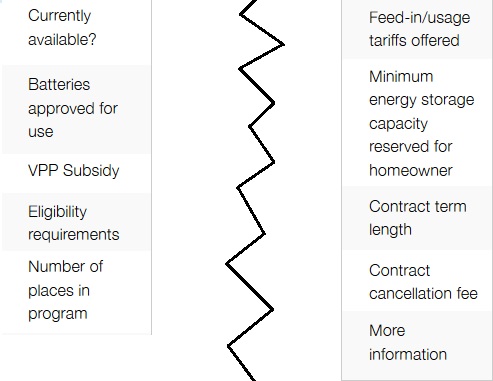
The jagged black line is supposed to indicate these row headings don’t go next to each other. (I’m expecting to receive my award for graphic design any day now.)
I think the titles of the row headings are self-explanatory. If they’re not, the terms are explained below the table. As detailed write-ups of individual VPPs are done, links to them will be added.
We also may add additional rows. I’m thinking perhaps we should have one that describes how easy it is for operators to abuse the terms and conditions of the VPP to the battery owner’s detriment. For example, are they permitted to charge and discharge the battery as much as they want without compensation, causing the battery to degrade while providing no benefit to its owner? Even if a Virtual Power Plant has no intention of doing this, I’m sure people will rest easier if they know that according to the terms and conditions, it can’t happen.
Home Batteries May Take Off Thanks To VPPs
The cost of producing battery cells has fallen a long way over the last few years, with large electric vehicle manufacturers apparently closing in on $150 per kilowatt-hour. Home battery prices have not reflected this decline in cell costs, but at least major manufacturers have been working on the serious reliability and durability issues home and business batteries have suffered from.
Once large companies start mass-producing well-tested and reliable battery systems, we should see some serious declines in price. Combined with the financial benefits that should come from joining a halfway honest VPP, we may soon have plenty of examples of home and business batteries paying for themselves. This could result in their installation rates sky rocketing. As more home and business batteries are installed, the returns from being part of a Virtual Power Plant will decline (mo’ VPPs, less arbitrage), but this may be more than offset by eventual declines in the cost of battery systems.
5 Minute Settlement Is Coming
If you’re thinking about getting a battery, but there are no VPPs available in your area that make it worthwhile, wait 18 months and things may be very different. This is because on the 1st of July 2021, our wholesale electricity market will change to 5 minute settlement periods. We currently have 5 minute prices, but these get averaged over 30 minutes. This has resulted in some shenanigans by generators gaming the market to push up wholesale electricity prices.
Once it changes to 5 minutes without averaging, it will be much easier for batteries to take advantage of ups and downs in electricity prices and charge up when it’s cheap or sell when it’s high. This should significantly increase the value of being in a VPP, so it may be best not to be locked into a long-term contract before that happens.

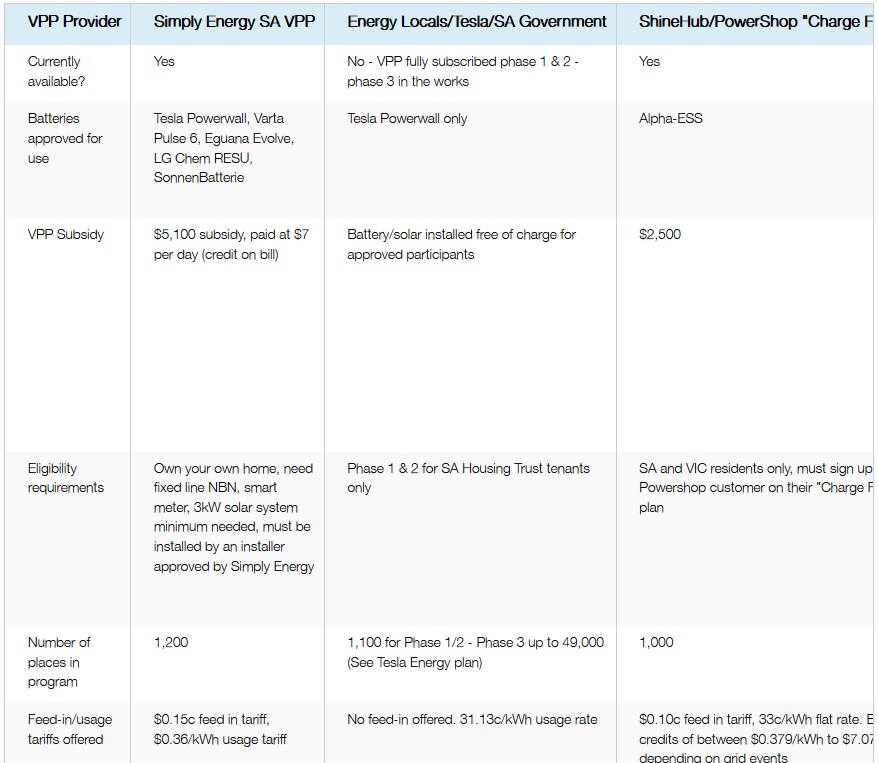
 RSS - Posts
RSS - Posts



So if enough of these v pee-pees are set up all over the country is there going to be a need for such a huge increase in electricity transmission infrastructure that has been discussed lately?
Interesting.
Because WA operates in a monopolistic shonkiness, hence only one VPP system is advertised for WA – the Plinker one;
”
Each standard installation includes:
5KVA Redback Inverter System
6.6kW Suntech 275w Solar PV (Photovoltaics) Panels
7.2kW Pylontech (LiFePo4) Battery
”
for $36.50 per week, with a 10 year minimum contract, with
“15% battery capacity is held in reserve for the homeowner.”
Now, 3650 per week, over 10 years, gives (using the truncated value of only 52 weeks per year) 36.50 x 52 x 10 = $18980.
That is for 6.6kW of panels, (only) a 7.2kWh battery, and, only 1kWh of the battery capacity being reserved for the household.
Comparing that with the system described at
https://www.deepcyclesystems.com.au/hybrid-solar-package-7-44kwh/
which, for easrtern states subsidies, has the cited cost of $18,000, fully installed, includiing GST, with that system description being
”
7.44KW PACKAGE INCLUDES:
24 x 310W Trina Tier 1 High Performance Monocrystalline Honey M Plus solar panels.
1 x 5kW SolaX SK-TL-5000E Hybrid Inverter with 1 x BMU-5000 Charge Controller (100Amps)
1 x DCS PV 13.5W (13.5kWh usable) Lithium Ion Battery (the latest in LiFePO4 battery cell technology backed with a industry leading 10 year / 80% capacity warranty)
Fully installed price, you only pay $17,999 Incl. GST (package price currently applicable for all of Brisbane/Sunshine/Gold Coast areas, VIC, NSW & TAS)
This price already takes into consideration any applicable government incentives.
”
whilst I do not know what would be the pricing including installation in WA, given the differences in capacity of both the photovoltaic panels and the battery storage (AND the supposed Depth Of Discharge of the batteries), and, that the household gets ALL of the battery capacity for usage, in the latter case, instead of only 1kWh, in the former case, to me, the latter case appears somewhat more feasible.
I am not promoting the latter case – I am merely using it as an example, to challenge the feasibility and practicality, of the former case.
I suggest that, for what is apparently, the only VPP proposal on offer in WA, at this stage, it is definitely a case of “le jeu n’en pas le chandelle” (if my memory of the spelling and wording, is correct).
Oh, one additional significant point that I neglected to include in my post above, is that, with the 6.6kW capacity limit on domestic rooftop photovoltaic panels connected to a single phase grid connection, whilst I have been told that that limit does not apply when battery storage is included in a domestic rooftop photovoltaic system, I do not know what is the applicable limit for such systems, so, I do not know whether the 7.44kW of total panels capacity, cited in the latter case, would be allowed in WA.
As, with the extraneous philosophical arguments relating to someone who purportedly lived two millennia ago, but, could not have, have clouded and digressed from the topic, so, my hinted question in my message above, may have been too subtly asked, or, otherwise overlooked due to the increasing fog in the extraneous comments, I will put this explicitly.
From what I understand, with a domestic rooftop photovoltaic system that does not include batteries, connected with a single phase connection to an electricity grid, the limit of the allowed total panels DC power capacity, is 4/3 the rated AC power output capacity of the inverter, up to a limit of 5kW AC power for the total output capacity of the inverter(s), and thence, 6.66kW DC power generation for the panels, for a particular household connected to the grid.
In the case of a household with a single phase electricity grid connection, for a domestic rooftop photovoltaic system that includes a storage battery system, whether the storage battery system has 10kWh capacity or 30kWh capacity, what are the applicable limits; both in terms of what the electricity grid connection regulators will approve, and, in terms of STC’s eligibility, for both the total panels generating capacity, and, for the inverter output capacity? Are the applicable limits the same, for systems that have battery storage, regardless of whether the systems have UPS capacity?
Or, are the applicable limits, the same, regardless of whether the domestic rooftop photovoltaic system includes battery storage?
Only downside to waiting 18months / after 5minute settlement arrive is if you are in SA where the rebate is reducing from 6k to 4k for instal /application orders after 15 April 2020.
*If* battery prices drop 2k in the next 18 months then it *may* be better to wait, but with certainty right now those in SA can get an installed Tesla PW2 battery to cost less than 4k at the end of all rebates
(6k from SA govt on application
+
5k from SE retailer over 2 years of with Simply Energy VPP if you’re willing to risk joining Simply Energy after reading their bad reviews)!
It does appear to pay for itself this way.
This current reward scheme *almost* pays for the battery & you’re essentially only paying for the installation and a small portion of the battery.
Assuming the retailer doesn’t screw you in the 2 -3 years that you’re with them.
Does this sound about right to you from your understanding Roland?
After reading and questioning the fine print I have trepidatiously applied to take the above risk (insert scared face or brave/stupid face here) to help our planet if not my bank balance & sanity.
Or, as Lazarus Long put it: “100 invested at 7 percent interest for 100 years will become 100,000, at which time it will be worth absolutely nothing.”
The computations can be found here:- https://books.google.com.au/books?id=jngt7TZ8dZ4C&pg=PA503&lpg=PA503&dq=lazarus+long…by+which+time+it+will+be+worth+nothing&source=bl&ots=_Duhkg9e3s&sig=ACfU3U09jwtIrq7KVOBIWK6jb1Me1-N5Tw&hl=en&sa=X&ved=2ahUKEwjMnLPLrZboAhUPfH0KHUL2Bx0Q6AEwAnoECAoQAQ#v=onepage&q=lazarus%20long…by%20which%20time%20it%20will%20be%20worth%20nothing&f=false
Sylvia Jones,
You quote Lazarus Long:
“100 invested at 7 percent interest for 100 years will become 100,000, at which time it will be worth absolutely nothing.”
The final yield is also dependent on the compounding interval;
$100 compounded at 7% per annum interest rate at YEARLY compound intervals for 100 years yields only $86,771.63;
At QUARTERLY compound intervals, the yield is $103,220.79;
At MONTHLY compound intervals, the yield is $107,455.55;
At DAILY compound intervals, the yield is $109,589.74
See: https://www.thecalculatorsite.com/finance/calculators/compoundinterestcalculator.php
Whether it will be worth anything in 100 years time will depend on inflation over that period. At the moment it is much lower than 7%. And taxes and fees.
https://www.rba.gov.au/inflation/measures-cpi.html
But if humanity can’t rapidly reduce (i.e. >50% reduction) human-induced GHG emissions within this decade, then it’s likely human civilization (and most likely all the investment facilities) will collapse before this century is over.
See David Spratt’s presentation at the recent (Feb 14-15) National Climate Emergency Summit 2020, particularly the slide he presents titled “1.5°C likely to be reached around 2030”: http://www.climatecodered.org/2020/02/a-climate-reality-update-at-2020.html
yesbut…….LL, being a couple of thousand years old, can only draw on the PAST; if he knew what the future held available he wouldn’t have bothered with another rejuvenation. He alo noted:-
What are the facts? Shun wishful thinking, ignore divine revelation, forget what “the stars foretell,” avoid opinion, care not what the neighbors think, never mind the unguessable “verdict of history”–what are the facts, and to how many decimal places? You pilot always into an unknown future, facts are your single clue.
Adaptation is the key; whether consciously determined or by pure reaction. Cockroaches have been around since before the dinosaurs and ill be around long after we’ve gone. I doubt they understood the niceties of investment: but they certainly had a feel for principles.
Sylvia,
You state:
“You pilot always into an unknown future, facts are your single clue.”
Like the clue that global atmospheric CO2 levels are increasing – passed 415 parts per million (ppm) in 2019 and still rising. The human species has never ever experienced CO2 levels this high before.
See: [The Keeling Curve Hits 415 PPM] https://www.youtube.com/watch?v=Z43FQCSg4Ow
Like the clue that empirical evidence indicates that (in the time when humans didn’t exist):
• In the Mid-Pliocene age, that occurred 3–4 million years ago, where atmospheric CO2 levels were in the range of 400–450 ppm, mean global temperatures were +2.0–3.0°C (above pre-industrial age), and sea levels were +10 – 22m higher than today (stabilized over centuries);
• In the Mid-Miocene age, that occurred 15–17 million years ago, where atmospheric CO2 levels were 300–500 ppm, mean global temperatures were +4.0–5.0°C, and sea levels were +10–60 m higher than today.
See from about time interval 0:23:23 through to 0:26:45 in Professor Schellnhuber’s presentation: [Keynote Debate Can the Climate Emergency Action Plan lead to Collective Action_ (50 Years CoR)] https://www.youtube.com/watch?v=QK2XLeGmHtE
A 1°C global mean temperature rise (above pre-industrial age) means the emergence of dangerous climatic conditions; 2°C means the onset of “extremely dangerous” climatic conditions; 3°C means ‘outright chaos”; and 4°C means “incompatible with organised global community”, or in other words, civilization collapse. These temperature rises are all possible before 2100 on our current human-induced GHG emissions trajectory.
Humanity and human civilization MIGHT adapt to Mid-Pliocene climate like conditions, but human civilization is highly likely to collapse in Mid-Miocene climate like conditions, with a global population likely declining below one billion people before 2100.
See: http://www.climatecodered.org/2019/08/at-4c-of-warming-would-billion-people.html
The key to the future is always path dependent. Compelling scientific evidence indicates that the GHG emissions path that humanity chooses within this decade, will likely determine whether human civilization as we know it will survive beyond the next few decades or not.
Adaptation MIGHT be possible in a Mid-Pliocene climate like condition, but in a Mid-Miocene climate like condition it’s likely large parts of the Earth will become uninhabitable and our food and water supplies will be inadequate to support billions of people.
What path do you suggest humanity should take?
The VPP guide may be a useful tool for reviewers Ron and thanks for getting it up and running.
I recommend that you add to it, a simple side by side comparator guide that precisely nails what the customers bottom line ends up being over a set billing cycle. This is the best way to present conclusions for just about anything regarding cyclic billing processes.
An example with meaning: Bill Jones gets 4 quarterly electricity bills each year thru 2019 and his RE configuration was what it was (and effectively remains constant into 2020).
Those bills have a single value representing the bottom line. Bill still has these bills in his filing cabinet. Bill joined a VPP deal in 2020 and his generator (solar component) remained the same size. Bill receives (or can collate from the VPP bills at least – a quarterly bill relating to the same period in 2019. There are then two single values to compare.
This is a useful start for Bill to then evaluate.
Of course the best circumstances for comparison are when nothing varies much in the way Bill conducts his day to day consumption.
Direct bill to bill bottom line comparisons are a good starting point and all of the technical ifs buts and maybes don’t deflect focus away from the bottom line thinking, which is what most of us ordinary folk find most interesting and useful when looking at financial transactions.
Lawrence Coomber
It’s a good idea and hopefully we’ll be able to provide historical information on how VPPs stack up after they’ve been operating for a while. At the moment I’m afraide the information required to work out what a particular VPP will save a household just isn’t out there. It would be possible to make an estimate for some of them, but I’m not too sure how to go about that at the moment.
… and a final comment by Lazarus Long, more relevant to the topic:-
“A human being should be able to change a diaper, plan an invasion, butcher a hog, conn a ship, design a building, write a sonnet, balance accounts, build a wall, set a bone, comfort the dying, take orders, give orders, cooperate, act alone, solve equations, analyse a new problem, pitch manure, program a computer, cook a tasty meal, fight efficiently, die gallantly. Specialization is for insects.”
I’ve noted that over time this site has degenerated to the ‘Specialist View’?
In the comparison table, as it is not an explicit component of the table, could a row be added; “States/Territories to which particular VPP applies”?
re: “Humanity and human civilization MIGHT adapt to Mid-Pliocene climate like conditions, but human civilization is highly likely to collapse in Mid-Miocene climate like conditions, with a global population likely declining below one billion people before 2100.”
‘Adaptation’ doesn’t preclude ‘change’. ie: those creatures which survived the Pliocene/Miocene were YOUR ancestors…or that portion of them that had the brains/skills/etc. to adapt to changing conditions. The ‘Fittest’. The ‘Unfit’ disappeared into the time-space continuum.
One might be surprised if even 20% ( ONE billion of the nearly FIVE billion currently alive) could muster enough of the required brains/skills/etc. required to ‘adapt’ to changing environments. Our species has, by and large, abandoned those qualities in exchange or a life of dependent ease. eg. endlessly haggling over (and complicating beyond belief) how to acquire the ‘best’ solar-system, installed/operated/maintained by complete strangers with dubious motives, whilst at the same time saving 32 cents per kw/KwH/Kva/AH/doodahs/whatever in the running of heir air-conditioners.
Have another look at ‘Soylent Green for the possibilities.
I’d suggest the best way to adapt to a warming planet is to stop burning coal. Following the camel route of developing a physiology that can survive temporary body temperature increases to 43 degrees would be more difficult.
And certainly your ‘suggestion’ might be a large step in the right direction. But then you write countless ‘explanations’ as to why we must all remain connected to the grid. The grid has little to offer without base-load (ie fossil-fuel – or atomic fusion ) power generation. The vagaries of intermittent solar-generation make grid-connection as useful as a baseball bat at a basket-ball game.
… and OOPS!. I did of course mean ‘atomic fission’.
Sylvia Jones,
You state:
“‘Adaptation’ doesn’t preclude ‘change’. ie: those creatures which survived the Pliocene/Miocene were YOUR ancestors…or that portion of them that had the brains/skills/etc. to adapt to changing conditions.”
There is no evidence that homo sapiens (humans) existed in the Mid-Pliocene age or earlier.
See: https://www.newscientist.com/article/dn24428-complete-skull-of-1-8-million-year-old-hominin-found/
Also: https://en.wikipedia.org/wiki/Timeline_of_human_evolution
The rate of change of climate is too fast for evolution – most species will likely become extinct (or if they can, move toward polar regions), and probably only a few humans will survive on a much more hostile planet, provided ‘tipping points’ don’t kick-in above about 2°C with positive feedbacks to drive a ‘hothouse Earth’ thermal runaway.
But why risk it when there are solutions to avoid it? Do you want humanity to suffer, Sylvia? Do you want your decedents (if you have any?) to suffer?
Lots of questions raised, including irrelevant/undefined ones. eg:- ‘suffering’ is an individual and undefinable quality. Would a masochist ‘suffer’ if he/she WASN’T being hurt?
In my, unrelated, opinion/understanding ‘suffering’ brings out the best in mankind, and is often what produces the greatest outcomes. (eg, even as a devout atheist I can admire the generic values of ‘religion’*… like the Yidkid who surrendered his life in the utmost suffering for an idealistic idea and a principle. (assuming without evidence the Jesus character ever actually existed.)
Your main point:- “There is no evidence that homo sapiens (humans) existed in the Mid-Pliocene age or earlier.” is irrelevant.
” ie: those creatures which survived the Pliocene/Miocene were YOUR ancestors”. WHATEVER the form or designation, those creatures which survived the Miocene/Pliocene (or even ‘that harlot the Pleistocene’ as Ardrey calls the spirit of that Age) WERE your ancestors – and mine.
Unless you’re suggesting some ghoulish ‘god’ created you ancestors from a handful of mud and a bone just 3600 years ago?.
*Ardrey suggests in passing, but convincingly, that ‘civilisation’ (including religion) was an evolutionary device which is primarily responsible for the survival of our species.
Sylvia,
You state:
“Lots of questions raised, including irrelevant/undefined ones.”
I think there are questions you label as “irrelevant” that you really don’t want to deal with – perhaps too inconvenient for you, Sylvia?
Then you follow with this drivel:
“eg:- ‘suffering’ is an individual and undefinable quality.”
The usual definition for suffering is: “the state of undergoing pain, distress, or hardship.” You say suffering is “undefinable” – Is suffering not familiar to you in your experience? Perhaps a charmed life so far for you, Sylvia?
You also state:
“WHATEVER the form or designation, those creatures which survived the Miocene/Pliocene (or even ‘that harlot the Pleistocene’ as Ardrey calls the spirit of that Age) WERE your ancestors – and mine.”
“Those creatures” evolved over millions of years (and none were humans), evidently adapting to very SLOW rates of changes in climate. In comparison, the Earth’s climate now is changing much, much FASTER – scientific evidence indicates if business-as-usual GHG emissions continues, a mean global temperature rise from now on of potentially around 0.4°C per decade – polar region temperatures are rising at a significantly faster rate. Global mean 1.5°C rise is inevitable as early as 2030. As I indicated earlier: The rate of change of climate is now too fast for evolutionary adaptation – most species will likely become extinct…
See: http://www.climatecodered.org/2020/02/a-climate-reality-update-at-2020.html
Has it occurred to you that “‘suffering’ brings out the best in mankind” may soon not be enough to avoid the escalating consequences of the Laws of Physics?
I sat down to plug the holes in your ‘argument’, but ran out of putty: only had 2 kg on hand. I’ll try to make it as simple as possible.
I ‘think’ your lack of comprehension, particularly in logic, is evident in your vapid use of generalities. “usually”/”evidently’/”probably” etc.etc. eg. Your long-winded exposition re. temperature/other variations in circumstances during the Miocene/Pliocene is quite IRRELEVANT (even if it WERE accurate). The point is that some creatures ADAPTED to whatever changes occurred, and the evidence lies in the reality that their descendants exist today.
You also don’t seem to grasp the ‘Law of Physics’ that differentiates between ‘evolution’ and ‘adaptation’ among other things. Your snide comment has the process arse-about. My original point was that the ‘survivors’ were the ones which ADAPTED; NONE of them were ‘born’ to survive as part of an evolutionary ‘plan’ or intention. We can’t foretell lightning strikes.
Whether homo-sapiens existed in the mid-Pliocene is IRRELEVANT. Homo-sapiens’ forebears DID. The time it took to do so – short or long – is irrelevant. (and only guessed at best).
This,also, is a daft assertion on several levels:- “The rate of change of climate is too fast for evolution – most species will likely become extinct (or if they can, move toward polar regions”. ‘Evolution’ is precisely what MEASURES the rate of change ~ in both living and non-living matter. Evolution does NOT cause the change; nor even the ‘rate of change’. Again, arse-about.’Our’ Universe exists as an adaptation to the ‘Big Bang’. Not the other way around. Whether you live or die, in a matter of years…or weeks, from an interaction with a stray photon from that Bang depends on how you ‘adapt’ to the resulting cancer.
Keep in mind that cockroaches have existed for over 300 MILLION years (ie TWENTY times the length of the Miocene) and survived countless environmental changes – including the recent Ice-Ages and the Man with the Mortein Can….. and nuclear radiation!* https://www.youtube.com/watch?v=AFe_yaH-KFQ (Since cockroaches still inhabit Hiroshima and Chernobyl it’s evident they survived the radiation long enough to reproduce: ie ‘adapted’ in Evolutionary terms.
I won’t waste any more time/effort/putty. But will only assert, again, that ‘suffering’ cannot have a “usual” context since it is absolutely subjective. However, I WILL direct you to a ‘definition’ arrived at by a more successful commentator than you or me:- http://www.raiseyourmind.com/wp-content/uploads/love-quotes-522.jpg
in the VPP plans, it only specifies the battery brand or type, so that means it doesn’t matter what the inverters brand ?
For an AC coupled battery like a Powerwall 2 the type of solar inverter doesn’t matter. For a DC coupled battery with a hybrid solar inverter it will have to be suitable for VPP use. Some VPPs subsidise the installation of a battery system, but only a suitable setup.